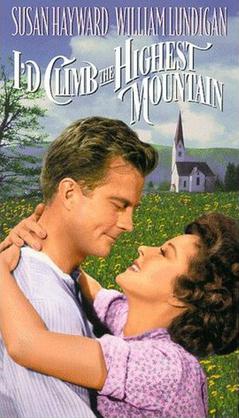I'd Climb the Highest Mountain
1951 film From Wikipedia, the free encyclopedia
I'd Climb the Highest Mountain is a 1951 Technicolor religious drama film made by Twentieth Century-Fox Film Corporation. It was directed by Henry King and produced by Lamar Trotti from a screenplay by Trotti. The story is based on a 1910 novel by Corra Harris about a minister and his wife in southern Appalachia (specifically Mossy Creek, Georgia) in the early 20th century. The film stars Susan Hayward and William Lundigan with Rory Calhoun, Barbara Bates, Gene Lockhart, Alexander Knox and Lynn Bari. The music score was by Sol Kaplan and the cinematography by Edward Cronjager.
| I'd Climb the Highest Mountain | |
|---|---|
 Video cover | |
| Directed by | Henry King |
| Written by | Lamar Trotti |
| Based on | A Circuit Rider's Wife 1910 novel by Corra Harris |
| Produced by | Lamar Trotti |
| Starring | Susan Hayward William Lundigan Rory Calhoun Barbara Bates Gene Lockhart Alexander Knox Lynn Bari |
| Cinematography | Edward Cronjager |
| Edited by | Barbara McLean |
| Music by | Sol Kaplan |
| Distributed by | Twentieth Century Fox |
Release date |
|
Running time | 88 minutes |
| Country | United States |
| Language | English |
| Box office | $2,150,000 (US rentals)[1][2] |
Plot
William Thompson is a minister from the Deep South who has recently married Mary Elizabeth, a city woman. William is assigned a new parish and moves with his wife to a town in Georgia's Blue Ridge Mountains, where he tends to the spiritual and emotional needs of his small flock. The poverty and isolation of the region, and the everyday problems of local people, put a strain on the couple's faith and marriage.
The townspeople have doubts about the new minister he must contend with, as well as helping his city-bred wife adjust to life in the country. As he shepherds his flock through hardships, including an epidemic leading to some deaths, he proves his worth as a pastor.
Cast
- Susan Hayward as Mary Elizabeth Eden Thompson
- William Lundigan as Rev. William Asbury Thompson
- Rory Calhoun as Jack Stark
- Barbara Bates as Jenny Brock
- Gene Lockhart as Jeff Brock
- Lynn Bari as Mrs. Billywith
- Ruth Donnelly as Glory White
- Kathleen Lockhart as Mrs. Brock
- Alexander Knox as Tom Salter
Production
The movie was shot in Dawsonville, Georgia, in the Appalachian Mountains, an unusual and out-of-the-way location at the time. Other scenes were shot in Sautee-Nacoochee, Georgia, Demorest, Georgia, and Cleveland, Georgia. On June 1, 1950, Hayward nearly lost her life when she slipped near a waterfall she was photographing. Luckily, William Gray, a studio chauffeur, caught her and they escaped with only minor injuries.[3] (Hayward would actually move to another part of rural Georgia a few years later, settling down to farm and ranch with her second husband when she was not making films. The couple are buried near the town of Carrollton, Georgia.)
References
External links
Wikiwand - on
Seamless Wikipedia browsing. On steroids.
